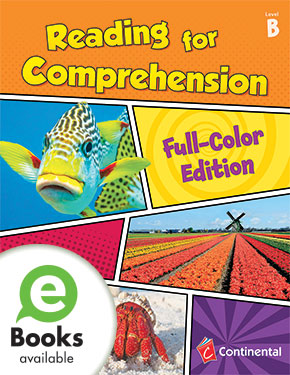5 Key Reading Comprehension Strategies and Activities to Boost Learning
Have you ever had a student who can read a passage fluently, but when you ask them to explain what they just read, they don’t know where to begin? Decoding is an important step in learning how to read, but students also need direct instruction on how to understand what they’re reading.
Reading comprehension can be a challenging skill to teach, but it’s crucial to our student’s success both in and out of the classroom. This blog will discuss reading comprehension strategies, how to improve reading comprehension, and fun reading comprehension activities to use with your class.
Why Is Reading Comprehension Important?
At its core, reading comprehension is the ability to make meaning from what you are reading. Carly Shuler, co-founder and co-CEO of Hoot Reading, says, “It involves the ability to process text, integrate it with what you already know, and understand it.”
According to Iris Reading, strong reading comprehension skills provide the following benefits to learners:
- Higher academic confidence
- Increased writing skills
- Effective critical thinking skills
- Improved problem-solving skills
- Higher levels of empathy
- Increased memory and recall
- Enhanced concentration and focus
Not only is reading comprehension a fundamental skill for language arts, but it’s also foundational to all academic success. The benefits of strong reading comprehension extend beyond the classroom.
Key Reading Comprehension Strategies
One of the reasons that teaching reading comprehension can be challenging is because it involves the integration of many different skills. There are several elemental reading comprehension strategies that good readers use to understand text:
- Connecting to background knowledge
- Summarizing
- Visualizing
- Sequencing
- Inferencing
- Predicting
- Comparing and contrasting
- Self-monitoring
- Differentiating between fact and opinion
- Determining the main idea, important facts, and supporting details
Strong readers use a variety of strategies as they read to construct meaning from the text.
According to Reading Rockets, “Most good readers do this with little or no explicit strategy instruction. Most students, however, can benefit greatly from organized, explicit instruction that teaches them to use specific strategies for understanding text. The good news is that specific comprehension strategies can be taught and learned – and that their deliberate use by readers improves comprehension.”

How to Improve Reading Comprehension
Researchers have worked to gather information on how students develop and use reading comprehension strategies to construct meaning. Studies have shown that reading comprehension is a complex skill that requires the coordination of multiple linguistic and cognitive processes.
Integrating the practices below into your reading instruction can boost your students’ reading comprehension and turn them into more effective readers.
1. Scaffold Instruction
Research has proven that direct instruction of a combination of techniques is the most effective way to improve reading comprehension skills. Students need to be explicitly taught reading comprehension strategies as well as when and why to use them. You can effectively scaffold their learning using the “I do, we do, you do” method.
In this instructional technique, teachers follow a gradual release method to guide students into independently applying new skills:
- Explain. During this step, teachers provide a direct explanation of the skill, as well as how and when to use it.
- Model. Next, teachers model the skill for the students. Often, this is done through a “think-aloud” where teachers can explain their thinking while reading a text.
- Provide guided practice. During this step, teachers offer support and guidance while students practice using the skill.
- Give independent practice. Lastly, students have the opportunity to apply what they’ve learned through independent practice. Teachers can then measure student understanding.
2. Activate Prior Knowledge
Background knowledge plays a vital role in reading comprehension skills. The more students know about a topic, the easier it will be for them to make meaning from what they’re reading.
You can help your students build and activate their background knowledge with the following:
- KWL charts
- Realia and visuals
- Virtual “field trips”
- Picture books
- Text sets
3. Develop Vocabulary
Research has proven that vocabulary knowledge supports reading comprehension. Much of our vocabulary is acquired through indirect exposure—listening to conversations, talking, listening to books, and reading independently. Regular reading contributes to strong vocabulary development.
Students also need intentional, effective vocabulary instruction. This involves teaching students both definitions of key terms and word-learning strategies that they can use independently. While all students will benefit from direct vocabulary learning, it is especially important for English language learners (ELLs).
Below are research-based teaching strategies to grow your students’ vocabularies:
- Provide student-friendly definitions.
- Use context clues to determine the meaning.
- Create interactive word walls.
- Have students sketch a picture that connects to the word’s meaning.
- Use semantic maps.
- Analyze word parts, such as root words and affixes.
- Provide multiple opportunities for review.
4. Teach Metacognition
Metacognition is defined as the awareness of one’s thought processes. By teaching your students to use metacognition as they are reading, they will be able to effectively self-monitor as they read—enabling them to catch errors and self-correct as needed.
When teaching metacognitive strategies, it’s important to name and model these strategies for your students. While reading, model “think-alouds” to show students how to reflect on their thought processes. Consider providing visuals such as an anchor chart with questions for students to ask themselves as they read.
5. Use Graphic Organizers
Graphic organizers are helpful tools for improving reading comprehension skills. They are extremely versatile—they can be used with any type of text from nonfiction to poetry and can be adapted for any learning level. Using graphic organizers also gives students the opportunity to practice the same reading comprehension strategies, such as identifying the main idea, across multiple genres.
Graphic organizers are powerful tools because they provide a visual representation of the text, making it easier for students to follow the story and identify key information. Teachers can use them as formative assessments to gather data on how to improve reading comprehension skills.
In addition, they can be used to facilitate the reading comprehension skills below. Click on the links to find free printables:
- Making connections
- Sequencing
- Identifying the main idea and details
- Comparing and contrasting
- Analyzing story elements
- Visualizing
- Understanding cause and effect
- Analyzing characters
- Making inferences
- Recording predictions

Fun Reading Comprehension Activities
Initially, the focus of reading instruction is more on the process of learning to read. As students progress, the goal of instruction shifts to reading to learn. It’s important to provide creative activities for them to practice their comprehension. These fresh ideas will keep your students engaged as they fine-tune their reading comprehension skills.
Read and Build
In this hands-on activity, students can construct scenes from stories using building blocks. Students can pick their favorite part of the story to recreate or have them choose a significant scene (and explain their reasoning) to incorporate higher-order thinking skills.
Individually, students can use them to retell the story. As a group, students can sequence the story together using their creations.
Clue Cards
Have students practice their visualization skills by using clue cards. After listening to you read each descriptive clue, students guess the object. Students can record their guesses by drawing a picture. After each clue, ask students if they changed their mind—and if so, why.
Beach Ball Comprehension
Get your students up and moving with this kinesthetic comprehension activity. Blow up a beach ball and write numbers around it using a permanent marker. Create a numbered list of comprehension questions to use—consider displaying the list on a chart or smart board so that students can reference it. Students can toss or roll the ball to each other and choose a question to answer.
Wanted Posters
This activity helps students develop the reading comprehension skills of visualization, character analysis, and identifying story elements—and it can be done with any age group. Have students create a “wanted” poster for a character, like an antagonist, from a story. Practice using visualization to draw a picture of the character, then identify character traits to include on the poster.
Picture of the Day
Teach your students how to make inferences by using a “picture of the day.” This can be done at any grade level—simply show students a photograph or illustration and ask questions to develop their inferential thinking.
Consider the reading comprehension strategy that you’re focusing on, and try to select images that support that skill. For example, a photograph of a building or specific location can help support understanding of the setting of a story. If you’re teaching cause and effect, you can find a picture of a melted ice cream cone on a sunny day.
With intentional instruction, teachers can help their students become effective, strategic, and metacognitive learners with strong reading comprehension skills.
 What Does the Science of Reading Say About Comprehension?
What Does the Science of Reading Say About Comprehension?
Reading comprehension is foundational to all academic success. As one of the five pillars of literacy, the importance of comprehension cannot be overstated.
Research from the Science of Reading gives us a roadmap for how to teach comprehension. In a 2021 article from Duke, Ward, and Pearson, the authors provide an overview of decades of research on reading comprehension. Below is a summary of their key points for how to teach comprehension.
- Begin comprehension instruction early.
- Teach foundational word-reading and bridging skills.
- Teach text structures and features.
- Understand that comprehension processes are specific to text and reader’s purpose.
- Develop vocabulary and activate background knowledge.
- Explicitly teach reading comprehension strategies.
- Encourage students to engage with text.
- Use instructional practices that kindle reading motivation.
Teachers can strengthen their students’ skills by using a differentiated and layered instructional approach with comprehension strategies.

Pique your readers' curiosity! This newest edition features lively comprehension practice with high-interest topics that are sure to motivate your students. Audio is available.
View Product →This blog was originally published on April 12, 2023. It was updated on February 12, 2024.

